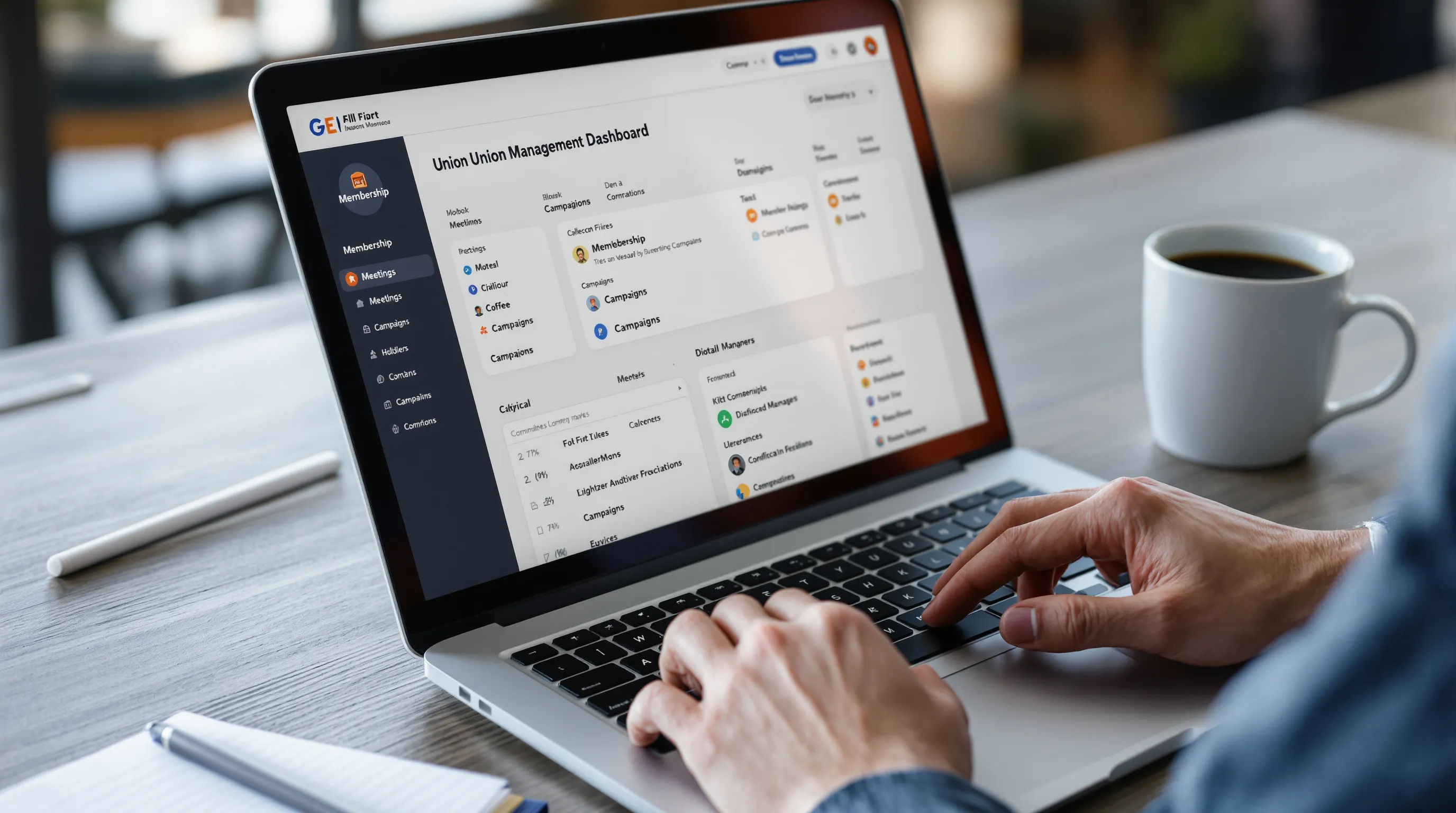

Content
Table of Contents
If you're running a local union, chances are you've felt the familiar frustration of bouncing between three different spreadsheets just to figure out who paid dues last month, while simultaneously trying to coordinate a grievance meeting and send campaign updates to your members.
Sound familiar? You're not alone. Most unions find themselves burning through hours that should be spent organizing; instead, they're stuck playing digital whack-a-mole with member communications in one system, grievance tracking in another, and event planning scattered across yet another platform.
Here's where union membership software steps in to change the game entirely. What union membership software does is bring all those scattered pieces together in one place. Your member databases, dues tracking, campaign work: everything lives in the same system instead of forcing you to hunt through different platforms every time you need something.
And we're not talking about some corporate CRM system that treats your members like customers. This software gets built by people who understand that organizing a contract vote is different from selling widgets.
The numbers tell the story too: the global Membership Management Software Market is projected to jump from $7.23 billion in 2023 to $25.02 billion by 2032; that's a 14.79% annual growth rate. But here's what matters more than market statistics: unlike those cookie-cutter business software packages that force you to bend your organizing work to fit their rigid structure, union membership software is designed around the real, messy, and complicated work of building worker power.
What is union membership software?
Union membership software is a digital platform designed specifically for labor unions to manage member information, streamline operations, and coordinate organizing activities, serving as command central for everything from member data to campaign communications.
At its core, union membership software combines several key functions.
Member database management keeps everyone's contact info, workplace details, dues status, and who showed up to what meeting all in one searchable spot. No more digging through old notebooks to remember which shift Maria works or when Joe last paid his dues.
Communication tools let you run phone banks, send texts, and blast emails without switching between apps. Whether you're doing one-on-one calls or reaching 500 members about a vote, it all happens from the same place.
Administrative automation handles the tedious tasks, such as dues collection, payment reminders, and compliance reports. You know, all those tasks that eat up your time but don't actually build power.

The software differs from generic customer relationship management (CRM) systems by including union-specific features. These might include grievance tracking, contract management, strike coordination, and multi-local reporting capabilities that standard business software lacks.
Modern union software integrates multiple communication channels within one system. Every text message, phone call, and email gets logged automatically to member profiles, creating complete engagement histories without manual data entry. This integration eliminates the coordination headaches that happen when member information gets scattered across different platforms.
Why unions use labor union management software
Unions face organizing challenges that drive the need for specialized software solutions. Managing large member databases across multiple locals, coordinating complex campaigns with limited staff, and maintaining member engagement between contract negotiations create administrative burdens that can derail organizing momentum. Union membership declined dramatically from 20.1% in 1983 with 17.7 million members to a historic low of 9.9% in 2024 with 14.3 million members, despite having the "most pro-union" presidential administration in recent memory.
Administrative efficiency becomes critical when you're trying to scale organizing work. Union software automates routine tasks like dues reminders, membership renewals, and basic communications. This automation frees up organizers to focus on relationship-building and campaign work rather than data entry and administrative coordination.
Unions that adopt specialized software see tangible results. Their organizers spend less time buried in administrative tasks and more time doing what matters most: connecting with members and building campaigns that win. Some unions using specialized management platforms have experienced up to 25% increases in timely dues collection rates, while engaged members are 59% more likely to renew their membership.
The reality is that unions using union organizing software report spending 60-70% more time on direct member engagement after implementing comprehensive union management software. In fact, unions implementing comprehensive management platforms spend 60-70% more time on direct member engagement and can reduce administrative time and costs by up to 70%. The technology handles data management and communication coordination while organizers focus on building relationships and winning campaigns.
Data organization eliminates the spreadsheet juggling that creates errors and wastes time. Union membership software maintains accurate member records, tracks participation across different activities, and generates reports that help leadership make strategic decisions about resource allocation and campaign priorities.
The reality is that unions using union organizing software report spending 60-70% more time on direct member engagement after implementing comprehensive union management software. The technology handles data management and communication coordination while organizers focus on building relationships and winning campaigns.
Core features of union software
Union management software comes with essential features that actually help with the day-to-day work of labor organizing. Each one tackles specific problems you're already dealing with when managing members and running campaigns.
Member database and profiles
Centralized member management stores all contact information, employment history, and participation data in one searchable system. Member profiles include workplace details, committee involvement, dues status, and complete interaction histories.
The database tracks member engagement across various activities, including meeting attendance, volunteer hours, campaign participation, and communication responses. This information helps organizers identify potential leaders and members who might need additional outreach or support.
Custom fields let you track the workplace stuff that actually matters: which department someone's in, what shift they work, who their supervisor is, or their job classification. When you need to reach all the night shift workers about a safety issue or figure out which manager is causing problems in shipping, having that information organized makes all the difference for your campaigns and grievance work.
Communication and outreach tools
Multi-channel communication capabilities coordinate phone banking, text messaging, and email campaigns from one platform. All communications get logged automatically to member profiles, creating complete engagement histories without manual data entry.
Phone banking features include predictive dialers that maximize conversation time, one-to-one calling for relationship building, and power dialers for efficient outreach. The system handles call routing, voicemail management, and conversation logging automatically.
Text messaging tools handle both blast messages to everyone and one-on-one conversations with individual members. The software keeps track of who's opted in, whether your messages actually got delivered, and lets you have real back-and-forth conversations with folks.
Email capabilities cover everything from newsletters and event invites to targeted messages based on who's active or which department they work in. Since it connects with your member database, you can personalize messages and set up automatic follow-ups without doing it all manually.
Dues and payment processing
Automated dues collection handles complex payment structures, recurring contributions, and payment reminders. The software supports different dues rates based on membership categories, income levels, or employment status.
Payment processing connects with secure systems so members can pay dues with credit cards, debit cards, or digital wallets like Apple Pay. They can set up automatic monthly payments or make one-time contributions through your website or mobile app.
Financial reporting keeps track of who's paying dues, who's behind, and collection rates across the board. These reports help your treasurer stay on top of union finances and spot members who might need a payment plan or just a friendly reminder call.

Grievance tracking and management
Digital grievance management keeps the whole process organized from when someone first files a complaint until it's resolved. The software tracks where each case stands, manages deadlines, assigns reps, and keeps all the paperwork in one place.
Case management lets you store evidence and correspondence, tracks deadlines so nothing falls through the cracks, and logs every conversation with members and management. No more hunting through email chains or wondering what happened in that meeting last month.
The reporting shows you patterns in what types of grievances keep coming up, how often you're winning cases, and how long things are taking. This helps leadership spot bigger workplace problems and figure out better ways to represent members.
Event and meeting coordination
Event management handles everything from shop floor meetings to national conventions. The software manages registrations, tracks attendance, processes payments, and coordinates complex logistics.
Registration systems collect attendee information, handle payment processing, and manage capacity limits. Automated communications send confirmations, reminders, and follow-up messages to maximize participation.
Attendance tracking records who participates in meetings and events, helping identify engaged members and those who might need additional outreach. This data supports leadership development and volunteer recruitment efforts.
Cross-local coordination makes solidarity campaigns and resource sharing possible while preserving local decision-making authority. You get the power of unified action without sacrificing each local's independence. Notably, Platform CRM use among unions doubled from 16% in 2020 to 32%, while 90% of unions now utilize Microsoft's Office 365 cloud office suite with an additional 7% currently transitioning.
Multi-local union software management
Unions with multiple locals need software that handles the big picture while letting each local run their own show. Multi-level chapter management gives you centralized oversight without stepping on each local's independence or identity.
The organizational structure keeps clear boundaries between different locals while everyone shares the same data system. Each local handles their own business but can still share resources and team up on bigger campaigns when it makes sense.
Permission systems control who sees what based on their role. Local officers get access to their chapter's information, while regional coordinators might need broader access for multi-local campaigns or sharing resources between chapters.
Cross-local coordination makes solidarity campaigns and resource sharing possible while preserving local decision-making authority. You get the power of unified action without sacrificing each local's independence.
Reporting gives you both local-specific numbers and organization-wide insights. Local leadership tracks their chapter's progress, while national officers can spot trends and see what's working across multiple locals.
How Solidarity Tech helps union membership software
Solidarity Tech offers comprehensive organizing tools specifically designed for union membership management and campaign coordination. The platform addresses common union challenges through integrated features built for labor organizing contexts.
Centralized member database and smart profiles
Solidarity Tech's member database consolidates all member information in one secure, searchable platform. Member profiles include complete interaction timelines showing text conversations, call notes, event attendance, and form submissions in chronological order.
Custom union-specific fields track workplace information like department, shift, and job classification. Members can be tagged with labels like "Strike Captain" or "Contract Committee" for quick filtering and targeted communications.
Streamlined grievance management
The platform digitizes the entire grievance process with specialized tracking tools. Create custom properties to track grievance status, type, and resolution while assigning representatives and setting follow-up tasks with deadlines.
Document management attaches evidence, correspondence, and settlement agreements directly to member profiles. Representative coordination assigns specific organizers to each case while maintaining clear communication records throughout the process.
Multi-channel communication tools
Solidarity Tech's communication system coordinates phone banking, email campaigns, and text messaging from one platform. The predictive dialer maximizes conversation time during contract votes or strike authorization campaigns.
Segmented messaging filters members by workplace, shift, language preference, or engagement level for targeted communications. Multilingual support communicates with members in their preferred language and routes conversations to appropriate organizers.
Event and convention management
The platform coordinates everything from shop floor meetings to national conventions with union-specific features. Multi-session events support conventions and conferences with different locations, times, and registration requirements.
Automated communications send event confirmations, reminders, and follow-ups while tracking RSVPs and attendance. Calendar invites include location details and virtual meeting links for hybrid events.
Chapter and local management
Solidarity Tech's multi-level structure supports unions with separate chapters based on geography, employer, or bargaining unit. Each chapter gets its own dedicated phone number while maintaining a connection to the broader organization.
Granular permissions set different access levels for staff, officers, stewards, and volunteers. Resource sharing enables template and script distribution across chapters while allowing local customization.
Reports that drive real organizing decisions
The reporting system tracks membership growth, engagement levels, and demographic trends to identify organizing opportunities. Campaign performance metrics measure outreach effectiveness and response rates.
Assessment tracking follows member development through different engagement levels, helping identify potential leaders and successful organizing tactics. The Wall Chart feature visualizes membership by department, shift, or other attributes for workplace mapping.
Common challenges with labor union management software
Even the best union software comes with implementation hurdles. Here's what to watch for when rolling out a new system, and how to overcome each challenge.
Complex due structures
Union dues aren't simple monthly fees like a gym membership. You've got different rates for retirees, apprentices, and full members, sliding scales based on what people earn, and special assessments when you need to fund a big campaign. Generic software chokes on this complexity.
Modern union software handles all these scenarios automatically. The system determines the right rate based on a member's membership status, sets up payment plans when members encounter financial difficulties, and manages special assessments when preparing for a contract negotiation or organizing drive.
Multi-local coordination
Organizations with multiple locals walk a tightrope between staying consistent and respecting each local's way of doing things. One chapter might prefer phone calls while another lives on text messages, or locals might have completely different grievance procedures that still need to fit in the same system.
Union membership software handles this through hierarchical setups that maintain data consistency while allowing each local to customize their workflow. National leadership receives the big-picture reports they need, while local officers maintain full control over their chapter's day-to-day operations and member relationships.
Data security and privacy
Union member information needs protection from both hackers and employers who might go after workers. Your member lists, grievance files, and organizing plans are the kind of sensitive information that could get people in real trouble if the wrong people get hold of it.
The security includes encryption for storing and transmitting data, access controls based on people's roles, and logs that track who looked at what information. Regular security updates and privacy compliance protect your members without slowing down your organizing efforts.
Build a stronger union with the right technology
Union membership software strengthens organizing capacity when it serves your strategy rather than dictating it. The right platform handles administrative tasks automatically while preserving the personal relationships that drive successful campaigns.
Technology works best when it eliminates friction in your organizing work. The software manages member data, coordinates communications, and generates strategic insights while organizers focus on building trust and winning concrete improvements for workers.
Your organizing becomes more effective when you can quickly mobilize members, track campaign progress, and maintain transparent operations. These capabilities strengthen your union's bargaining position and capacity to advocate for members' interests.
To explore how comprehensive organizing platforms can enhance your union's effectiveness, schedule a demo with Solidarity Tech.
FAQs about union membership software
What does union membership software typically cost for small locals?
Small locals with 50-200 members typically pay between $29-99 per month for union membership software. Many platforms offer flat-rate pricing regardless of membership size, which often proves more cost-effective than per-member pricing structures.
Can union membership software integrate with existing accounting systems?
Most modern union software connects with accounting platforms like QuickBooks and Xero through built-in integrations. These connections automatically sync dues payments and financial data, eliminating double data entry and reducing bookkeeping errors.
How long does implementing new union management software typically take?
Implementation typically takes 2-8 weeks, depending on your data and customization needs. If you've got clean data and straightforward requirements, you'll be up and running in 2-3 weeks. More complex multi-local setups might need 6-8 weeks to deploy fully.
Is union membership software secure enough for sensitive member information?
Union software protects your members' information with bank-level encryption and strict access controls. The best platforms are regularly audited for security and meet all major data protection standards, so your sensitive organizational data stays safe.
Can union software handle multiple locals with different dues structures?
Modern union membership software works with multi-local organizations through hierarchical setups that handle different dues rates and local-specific rules in one system. Each local keeps its own procedures while getting the benefits of consolidated reporting and coordination tools.
read more
Explore More Union Organizing Resources
From forming a union to using modern organizing software, discover how workers build lasting strength together




